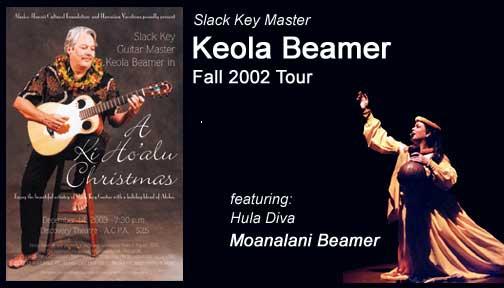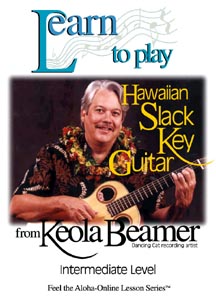

Keola
Beamer
is a master of Hawaiian artistic expression. The fascinating history of
his family can be traced back to the 15th century, to such distinguished
küpuna (ancestors) as Ahiakumai Kiçekiçe, queen of
the island of Hawaii, one of the kapu (sacred) twins born of Kameiamoku,
favored wife of Kamehameha Nui. In traditional Hawaiian society, aliçi
(royalty) recognized that sounded words possess mana (spiritual power).
They encouraged musical expression as a way to preserve information and
communicate with one another and the gods.
Throughout the generations, the Beamers have been involved
in the performing arts. In the 20th century, they have produced a number
of influential performers, composers and teachers. Keola’s great
grandmother, Helen Kapuailohia Desha Beamer, was one of Hawaiçi’s
most prolific and accomplished composers. She was also a skilled dancer
whose grace left a lasting imprint on the hula (Hawaiian dance). Her granddaughter,
Winona (Nona) Kapuailohia Beamer, is Keola’s mother. A noted chanter,
composer and singer, Nona is revered for her scholarship and accomplishments
in the education of Native Hawaiian children.
Keola's newest recording, Soliloquy, released in January, 2002 on Dancing Cat Records, is getting rave reviews and serious airplay nationwide. Soliloquy presents Keola in a unique environment, alone with his guitar. There is a magical synergy that is present. On Soliloquy, Keola sets aside the native percussion and nose flute to just have a moment with his guitars. Soliloquy debuted at #15 on the Billboard World Music charts, peaking at #11.
Keola continues to expand on the Slack Key tradition as well. A guitar concerto, written for his style, is in the works, as are plans for several crosscultural collaborations to follow the recent landmark meeting with Taiko artist, Kenny Endo. The pair were commissioned by Stanford's Lively Arts Series to perform two concerts; at Stanford University and Japan American Cultural Center Theater in Los Angeles. He is currently working on a theatre musical and a documentary soundtrack and in March he will begin work on the soundtrack for a major motion picture.
In March of 2001, Maui based filmmaker, Ken Burgmaier, filmed Keola in concert at the Maui Arts and Cultural Center. What began as as footage for Burgmaier's Jazz Alley TV series on the BET network, blossomed into a full feature documentary about Keola, with testimonials from his island peers, Led Ka'apana, Cindy Combs and Cyril Pahinui, along with commentary from such diverse luminaries as George Winston and fellow Mauian, Willie Nelson. The film, entitled Keola Beamer: Slack Key Guitar- Loosen the key, made its debut in Honolulu last September. It is scheduled to screen at major film festivals in New York, Denver and Los Angeles in 2002.